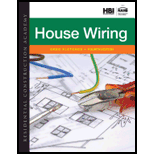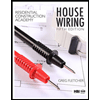
Residential Construction Academy: House Wiring (MindTap Course List)
4th Edition
ISBN: 9781285852225
Author: Gregory W Fletcher
Publisher: Cengage Learning
expand_more
expand_more
format_list_bulleted
Concept explainers
Question
Chapter 3, Problem 1RQ
To determine
The correct match of the given hand tools to their common residential electrical trade use.
Expert Solution & Answer
Explanation of Solution
The following table shows the correct match of the given hand tools to their common residential electrical trade use:
| Hand tools | Use |
| 1. Lineman pliers | b. Used to cut cables and conductors, form large conductors, and pull and hold conductors |
| 2. Adjustable wrench | a. Used to remove and install slot-head screws and to tighten and loosen slot-head pressure connectors |
| 3. Wire strippers | e. Used to strip insulation from conductors |
| 4. Electrician’s Knife | g. Used to strip large conductors and cables |
| 5. Philips Screwdriver | j. Used to drive and pull nails, pry boxes loose, and strike chisels |
| 7. Triple-tap tool | h. Used to tap 6-32, 8-32, and 10-32 holes for securing equipment to metal, re-tap damaged threads, and determine screw sizes. |
| 8. Long-nose pliers | c. Used to form small conductors, cut conductors, and to hold and pull conductors |
| 9. Multipurpose tool | f. Used to strip insulation, crimp solder-less connectors, cut and size conductors, and cut and thread small bolts |
| 11. Awl | i. Used to start screw holes, make pilot holes for drilling, and mark metal |
| 12. Diagonal pliers | d. Used to cut cables and conductors in a limited space |
Want to see more full solutions like this?
Subscribe now to access step-by-step solutions to millions of textbook problems written by subject matter experts!
Students have asked these similar questions
A gravity retaining wall is shown in the figure below. Calculate the factor of safety with respect to overturning and sliding, given the following data:
Wall dimensions: H = 6 m, x1 = 0.6 m, x2 = 2 m, x3 = 2m,
x4 0.5 m, x5 = 0.75 m, x6 = 0.8 m, D= 1.5 m
Soil properties: 71 = 15.5 kN/m³, ₁ = 32°, Y2 = 18 kN/m³,
2=22°, c₂ = 40 kN/m²
H
x6
X2 TXT
X3
Use Coulomb's active earth pressure in your calculation and let ' = 2/3 01. Use Yconcrete = 23.58 kN/m³. Also, use k₁ = k₂ = 2/3 and P = 0 in equation
FS (sliding)
(ΣV) tan(k₁₂2) + Bk2c + Pp
Pa cos a
For 1 = 32°, a = 0°, B = 71.57°, Ka = 0.45, 8' = 21.33°.
(Enter your answers to three significant figures.)
FS (overturning)
FS (sliding)
=
For the cantilever retaining wall shown in the figure below, let the following data be given:
Wall dimensions: H = 6.5 m, x1 = 0.3 m, x2 = 0.6 m, x3 = 0.8 m,
x4 2 m, x5 = 0.8 m, D= 1.5 m, a = 0°
Soil properties: 71 = 17.08 kN/m³, ₁ = 36°, Y2 = 19.65 kN/m³,
2 = 15°, c₂ = 30 kN/m²
For 2=15°: N = 10.98; N₁ = 3.94; N₁ = 2.65.
x2
..
c₁ = 0
Φί
H
x5
Calculate the factor of safety with respect to overturning, sliding, and bearing capacity. Use Yconcrete = 24.58 kN/m³. Also, use k₁ = k2 = 2/3 and P₂ = 0 in equation
(EV) tan(k102) + Bk2c₂ + Pp
FS (sliding)
Pa cos a
(Enter your answers to three significant figures.)
FS (overturning)
FS (sliding)
FS (bearing)
=
=
=
A) # of Disinfection Clearwells: 3
B) Clearwell Operation Style: Parallel (to provide contact time for disinfection
using free chlorine (derived from a hypochlorite solution generated onsite).
C) The facility's existing system to generate hypochlorite onsite has reached
the end of its useful life, and the current operating capacity is insufficient
to generate the required mass flow of hypochlorite to accommodate the
future capacity of 34.5 MGD. Assume the facility plans to stop generating
hypochlorite onsite and will instead purchase a bulk solution of sodium
hypochlorite
D) Sodium hypochlorite (NaOCI) concentration: 6.25% NaOCI by mass
E) Bulk Density: 1,100 kg/m^3
F) Clearwell T10/DT Ratio: (CW1 0.43). (CW2 = 0.51), (CW3 = 0.58)
DT is the theoretical mean hydraulic retention time (V/Q)
G) pH: 7.0
H) Design Temperature: 15°C
1) 50% of Chlorine is lost in each clearwell
J) If the concentration going into the clearwell is C, then you can assume that
the concentration leaving the…
Chapter 3 Solutions
Residential Construction Academy: House Wiring (MindTap Course List)
Knowledge Booster
Learn more about
Need a deep-dive on the concept behind this application? Look no further. Learn more about this topic, civil-engineering and related others by exploring similar questions and additional content below.Similar questions
- Please explain step by step, and show formulaarrow_forwardNote: Please deliver a clear, step-by-step simplified handwritten solution (without any explanations) that is entirely manually produced without AI assistance. I expect an expert-level answer, and I will evaluate and rate it based on the quality and accuracy of the work, using the provided image for additional reference. Ensure every detail is thoroughly checked for correctness before submission.arrow_forwardPlease don't explain it. But draw it out for me kindly. And appreciate your time!. All the info is in the images. Thanks!.arrow_forward
- Design a simply supported one-way pavement slab for a factored applied moment, Mu = 10 ft-kip. Use f c’ = 5,000 psi and f y = 60,000 psi. The slab is in permanent contact with soil.Hint:• Estimate a minimum slab thickness for deflection control.• Solve for the slab steel based on cover for soil contactarrow_forwardThe figures below shows the framing plan and section of a reinforced concrete floor system. Floor beams are shown as dotted lines. The weight of the ceiling and floor finishing is 6 psf, that of the mechanical and electrical systems is 7 psf, and the weight of the partitions is 180 psf. The floor live load is 105 psf. The 7 in. thick slab exterior bay (S-1) is reinforced with #5 rebars @ 10 in. o.c. as the main positive reinforcement at the mid span, and #4 @ 109 in. for the shrinkage and temperature reinforcement. The panel is simply supported on the exterior edge and monolithic with the beam at the interior edge. Check the adequacy of the slab. Use the ACI moment coefficients. fc’ = 6,000 psi and fy = 60,000 psi. The slab is in an interior location. Hint: • Estimate total dead load. Find factored maximum positive bending moment in the end span. • Find design positive moment capacity. • Compare and determine adequacy, including safety and economy.arrow_forward1 For an reinforced concrete two-way slab shown in figure under the load (P). (the slab continuous over all edges - all sides are fixed), Determine (By using yield line theory): A- Draw the Yield line Pattern B- Determine the moment m C- Find The required flexural steel to resist the loads causing the slab to collapse if P = 200 KN, f=28 MPa, fy = 420 MPa d = 120 mm. Use 10 mm bars. (Prin = 0.002) +2 m 6 m -8 m 3 marrow_forward
- At a point on the surface of a generator shaft the stresses are σx = -55MPa, σy = 25MPa and Txy = -20MPa as shown in Figure Q1. (a) Using either analytical method or Mohr's circle determine the following: Stresses acting on an element inclined at an angle 0 = 35°, i. ii. iii. The maximum shear stress The principal stresses and B. 25 MPa A 55 MPa 20 MPa Figure 1:Material stress state (b) Consider that the Young's modulus for the material, E = 200kPa and Poisson's ratio, v = 0.25. i. ii. determine associate strains for the material with the stress as shown in Figure 1 determine associate strains for the material with the stress at element oriented at 35° (question 1a(i))arrow_forwardA study reports data on the effects of the drug tamoxifen on change in the level of cortisol-binding globulin (CBG) of patients during treatment. With age = x and ACBG = y, summary values are n = 26, Σx, = 1612, Σ(x, - x)² = 3756.96, Σy, = 281.9, Σ(y, - y)² = 465.34, and Ex,y,= 16,745. (a) Compute a 90% CI for the true correlation coefficient p. (Round your answers to four decimal places.) (b) Test Hop=-0.5 versus H: p< -0.5 at level 0.05. Calculate the test statistic and determine the P-value. (Round your test statistic to two decimal places and your P-value to four decimal places.) z = P-value = State the conclusion in the problem context. ◇ Reject Ho. There is no evidence that p < -0.5. ○ Fail to reject Ho. There is evidence that p < -0.5. Reject Ho. There is evidence that p < -0.5. Fail to reject Ho. There is no evidence that p < -0.5. (c) In a regression analysis of y on x, what proportion of variation in change of cortisol-binding globulin level could be explained by variation in…arrow_forwardFor the frame and loading shown, determine the reactions at A and C. 24 Last 2 student ID+50 lbs 24 A 3 in. B A=Last 2 student ID+10 Inch B=Last 2 student ID+40 Inch A B Darrow_forward
- The figures below shows the framing plan and section of a reinforced concrete floor system. Floor beams are shown as dotted lines. The weight of the ceiling and floor finishing is 6 psf, that of the mechanical and electrical systems is 7 psf, and the weight of the partitions is 180 psf. The floor live load is 105 psf. The 7 in. thick slab exterior bay (S-1) is reinforced with #5 rebars @ 10 in. o.c. as the main positive reinforcement at the mid span, and #4 @ 109 in. for the shrinkage and temperature reinforcement. The panel is simply supported on the exterior edge and monolithic with the beam at the interior edge. Check the adequacy of the slab. Use the ACI moment coefficients. fc’ = 6,000 psi and fy = 60,000 psi. The slab is in an interior location. Hint: • Estimate total dead load. Find factored maximum positive bending moment in the end span. • Find design positive moment capacity. • Compare and determine adequacy, including safety and economy. C Darrow_forwardFor an reinforced concrete two-way slab shown in figure under the load (P). (the slab continuous over all edges - all sides are fixed), Determine (By using yield line theory): A- Draw the Yield line Pattern B- Determine the moment m C- Find The required flexural steel to resist the loads causing the slab to collapse if P = 200 KN, f=28 MPa, fy = 420 MPa d = 120 mm. Use 10 mm bars. Draw the yield line and (Qmin = 0.002) 2m solve PO 6 m 3 m -8 marrow_forwardFind the internal torques for segments AB, BC, and CD (in N-m) by drawing the internal torque diagram, the maximum torsional shear on the shaft in MPa, and the relative rotation of section A with respect to section D in degrees.arrow_forward
arrow_back_ios
SEE MORE QUESTIONS
arrow_forward_ios
Recommended textbooks for you
 Residential Construction Academy: House Wiring (M...Civil EngineeringISBN:9781337402415Author:Gregory W FletcherPublisher:Cengage Learning
Residential Construction Academy: House Wiring (M...Civil EngineeringISBN:9781337402415Author:Gregory W FletcherPublisher:Cengage Learning Residential Construction Academy: House Wiring (M...Civil EngineeringISBN:9781285852225Author:Gregory W FletcherPublisher:Cengage Learning
Residential Construction Academy: House Wiring (M...Civil EngineeringISBN:9781285852225Author:Gregory W FletcherPublisher:Cengage Learning

Residential Construction Academy: House Wiring (M...
Civil Engineering
ISBN:9781337402415
Author:Gregory W Fletcher
Publisher:Cengage Learning

Residential Construction Academy: House Wiring (M...
Civil Engineering
ISBN:9781285852225
Author:Gregory W Fletcher
Publisher:Cengage Learning